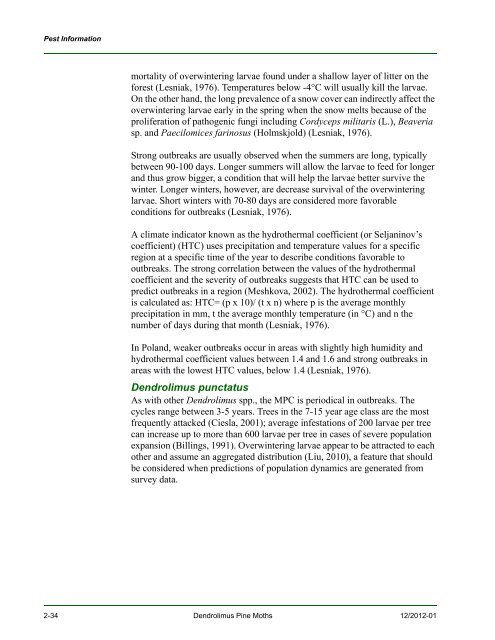New Pest Response Guidelines - aphis - US Department of Agriculture
New Pest Response Guidelines - aphis - US Department of Agriculture
New Pest Response Guidelines - aphis - US Department of Agriculture
Create successful ePaper yourself
Turn your PDF publications into a flip-book with our unique Google optimized e-Paper software.
<strong>Pest</strong> Information<br />
mortality <strong>of</strong> overwintering larvae found under a shallow layer <strong>of</strong> litter on the<br />
forest (Lesniak, 1976). Temperatures below -4°C will usually kill the larvae.<br />
On the other hand, the long prevalence <strong>of</strong> a snow cover can indirectly affect the<br />
overwintering larvae early in the spring when the snow melts because <strong>of</strong> the<br />
proliferation <strong>of</strong> pathogenic fungi including Cordyceps militaris (L.), Beaveria<br />
sp. and Paecilomices farinosus (Holmskjold) (Lesniak, 1976).<br />
Strong outbreaks are usually observed when the summers are long, typically<br />
between 90-100 days. Longer summers will allow the larvae to feed for longer<br />
and thus grow bigger, a condition that will help the larvae better survive the<br />
winter. Longer winters, however, are decrease survival <strong>of</strong> the overwintering<br />
larvae. Short winters with 70-80 days are considered more favorable<br />
conditions for outbreaks (Lesniak, 1976).<br />
A climate indicator known as the hydrothermal coefficient (or Seljaninov’s<br />
coefficient) (HTC) uses precipitation and temperature values for a specific<br />
region at a specific time <strong>of</strong> the year to describe conditions favorable to<br />
outbreaks. The strong correlation between the values <strong>of</strong> the hydrothermal<br />
coefficient and the severity <strong>of</strong> outbreaks suggests that HTC can be used to<br />
predict outbreaks in a region (Meshkova, 2002). The hydrothermal coefficient<br />
is calculated as: HTC= (p x 10)/ (t x n) where p is the average monthly<br />
precipitation in mm, t the average monthly temperature (in °C) and n the<br />
number <strong>of</strong> days during that month (Lesniak, 1976).<br />
In Poland, weaker outbreaks occur in areas with slightly high humidity and<br />
hydrothermal coefficient values between 1.4 and 1.6 and strong outbreaks in<br />
areas with the lowest HTC values, below 1.4 (Lesniak, 1976).<br />
Dendrolimus punctatus<br />
As with other Dendrolimus spp., the MPC is periodical in outbreaks. The<br />
cycles range between 3-5 years. Trees in the 7-15 year age class are the most<br />
frequently attacked (Ciesla, 2001); average infestations <strong>of</strong> 200 larvae per tree<br />
can increase up to more than 600 larvae per tree in cases <strong>of</strong> severe population<br />
expansion (Billings, 1991). Overwintering larvae appear to be attracted to each<br />
other and assume an aggregated distribution (Liu, 2010), a feature that should<br />
be considered when predictions <strong>of</strong> population dynamics are generated from<br />
survey data.<br />
2-34 Dendrolimus Pine Moths 12/2012-01

















